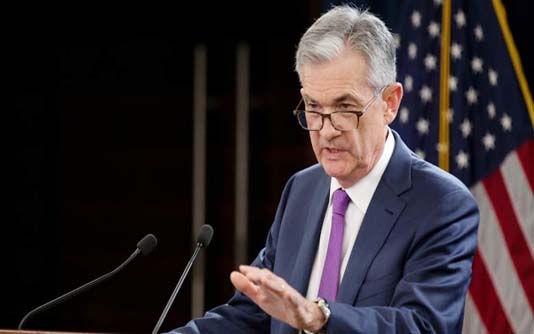WASHINGTON, Jan 31, 2019 (BSS/AFP) – The Federal Reserve left the key US
lending rate unchanged on Wednesday, and said it would be “patient” about
making any further changes, in the clearest signal yet the central bank has
heeded concerns about the economy.
And Federal Reserve Chairman Jerome Powell followed that dovish
statement by saying “the case for raising rates has weakened somewhat,” given
low inflation and amid “cross-currents and risks” buffeting the US economy
that will be around for a while.
“In this environment we believe we can best support the economy by being
patient in evaluating the outlook before making any future adjustment to
policy,” Powell said at a press conference.
Although the Fed expects that continued expansion of the economy and
strong job growth are the “most likely outcomes,” the statement signaled the
growing uncertainty about the outlook.
“In light of global economic and financial developments and muted
inflation pressures, the committee will be patient as it determines” the
timing and need for any further increases, the policy-setting Federal Open
Market Committee said.
In an unusual separate statement, the Fed also said it was prepared to
change the pace of reduction of its massive securities holdings, after
markets became concerned that the current process was too rigid.
The language used by the FOMC, after the unanimous vote to keep the
benchmark interest rate in a range of 2.25 percent to 2.5 percent, reflected
the increasing sense that the US economy may have peaked.
It cited “solid” economic growth, rather than a “strong rate of growth”
highlighted in prior statements.
The decision at the Fed’s first policy meeting of the year was expected
after central bankers signaled strongly in recent weeks that they intended to
tread cautiously about any further moves.
But the unusually dovish language likely will come as a surprise.
US stocks added to gains following the Fed statement, with the Dow spiking
after the statement and closing up 1.8 percent.
The dollar also weakened sharply after Powell’s news conference, with the
euro at $1.1477 shortly after 2100 GMT, compared to $1.1421 just before the
statement.
– ‘Cross-currents and risks’ –
The FOMC increased the benchmark rate four times last year but rising
concerns about a slowing US economy, amid a trade war with China, prompted
officials to signal they would take time to gauge the economy’s performance.
And the five-week government shutdown also dented economic performance in
the first quarter of the year, although most of that is expected to be
recovered.
However, Powell cautioned that another shutdown or drawn out trade
negotiations with China could hurt the economy by sapping business
confidence.
A second shutdown could have “a permanent effect or lasting effect,” he
said.
And while the impact of the tariffs Washington and Beijing have imposed on
goods so far have not had “material effects on GDP either here or in China.”
However, “a longer drawn out set of negotiations back and forth which
could result in sapping business confidence. Uncertainty is not the friend of
business.”
– Balance sheet change possible –
Powell late last year repeatedly shook up markets with comments considered
to be overly optimistic and hinting at more rate hikes to come.
Facing blowback from his efforts to speak plainly, Powell retreated from
his stance and made an effort to stress the uncertainty about the economic
outlook and acknowledged that in this case the Fed took note of the
“sustained change in financial conditions.”
But he declined to put a timeframe on the Fed’s patience, saying “the
length of this patient period is going to depend entirely on incoming data
and its implications for the outlook.”
One of the concerns was the effect of the Fed’s system for gradually
reducing its securities holdings, which built up to $4.5 trillion in the
aftermath of the global financial crisis.
It has been reducing those investments by about $50 billion a month but
investors worry that in a slowing economy that process will tend to raise the
cost of borrowing.
The statement on the balance sheet normalization process said the Fed
“would be prepared to use its full range of tools, including altering the
size and composition of its balance sheet, if future economic conditions were
to warrant a more accommodative monetary policy.”
Powell stressed that the goal was to reduce the Fed’s holdings without
“unnecessary market turmoil.”



